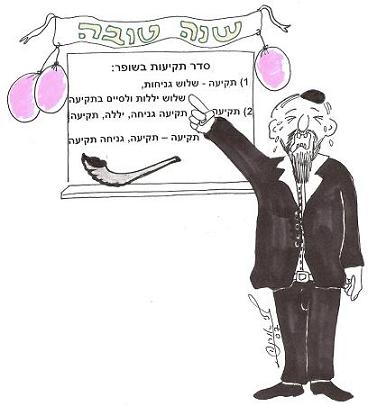
The early sages (the Tanaaim) ruled that one should blow the shofar on Rosh Hashanah. They also ruled the manner and number of notes to be sounded during the blowing of the shofar: tekiyah — teruah — tekiyah. A simple and elongated note is to be sounded from the shofar — this is called tekiyah. Afterwards broken notes are to be sounded from the shofar — this is called teruah. Then again we sound the simple and elongated note. They also ruled that the simple elongated note must be held for three times as long as the broken notes (teruah) are held, and the teruah notes are to be as long as three breaths, what the sages called “three whimpers.” The scholars asked: In another place the early sages said that the length of the simple note (the tekiyah) is equal to the length of the broken notes (teruah), in contrast to the opinion that it is three times as long. Answer: Both refer to the same amount of time — the length of the tekiyah is the length of the teruah, but the text was garbled and should have read that three tekiyot are as long as three teruot. The scholars went on to ask: According to another sage, the length of a teruah is as the length of three simple short notes, “three whimpers,” but in another place it is said that the length of a teruah is as three long notes, “three shevarim.” Answer: These are different opinions from different sages on the length of a teruah. Why do they disagree? The scholars answered: The Torah uses the words “A day of teruah shall it be for you,” and Onkeles the convert translates teruah as yevavah, weeping and whimpering. This means that the teruah note should be as the sound of a person’s weeping. Since there are two forms of crying, that which sounds like whimpering — short sounds — and that which sounds like moaning — longer sounds — one sage supposed that the length of a teruah must be as the length of whimpering and the other supposed it must be as the length of a moan. One of the sages, R’ Avahu, made a practical ruling for those who blow shofar, to cover all opinions, that the notes sounded be tekiyah, three moans, three whimpers, and a final tekiyah. One of the scholars, Rav Oyura, asked whether the above ruling creates a problem because the teruah might only be the whimpering sound and once we add in the moaning sound, we are sounding notes with no reason and cause a break in the continuum of notes sounded. Answer: The sage ruled that we blow all possible notes: tekiyah whimper tekiyah, tekiyah moan tekiyah, tekiyah moan whimper tekiyah. The scholars then asked: There is still the option of tekiyah whimper moan tekiyah. Answer: Since it is the nature of a person who is crying to first moan and only then whimper, it is reasonable to suppose that if we need to sound both sets of notes, it would follow the order of moan and then whimper.
(Babylonian Talmud, Tractate Rosh Hashanah 33b-34a)
